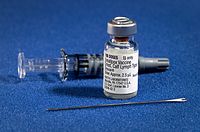
Photo from wikipedia
Immunosenescence describes immune dysfunction observed in older individuals. To identify individuals at‐risk for immune dysfunction, it is crucial to understand the diverse immune phenotypes and their intrinsic functional capabilities. We… Click to show full abstract
Immunosenescence describes immune dysfunction observed in older individuals. To identify individuals at‐risk for immune dysfunction, it is crucial to understand the diverse immune phenotypes and their intrinsic functional capabilities. We investigated immune cell subsets and variation in the aging population. We observed that inter‐individual immune variation was associated with age and cytomegalovirus seropositivity. Based on the similarities of immune subset composition among individuals, we identified nine immunotypes that displayed different aging‐associated immune signatures, which explained inter‐individual variation better than age. Additionally, we correlated the immune subset composition of individuals over approximately a year as a measure of stability of immune parameters. Immune stability was significantly lower in immunotypes that contained aging‐associated immune subsets and correlated with a circulating CD38 + CD4+ T follicular helper cell increase 7 days after influenza vaccination. In conclusion, immune stability is a feature of immunotypes and could be a potential indicator of post‐vaccination cellular kinetics.
Journal Title: Aging Cell
Year Published: 2022
Link to full text (if available)
Share on Social Media: Sign Up to like & get
recommendations!